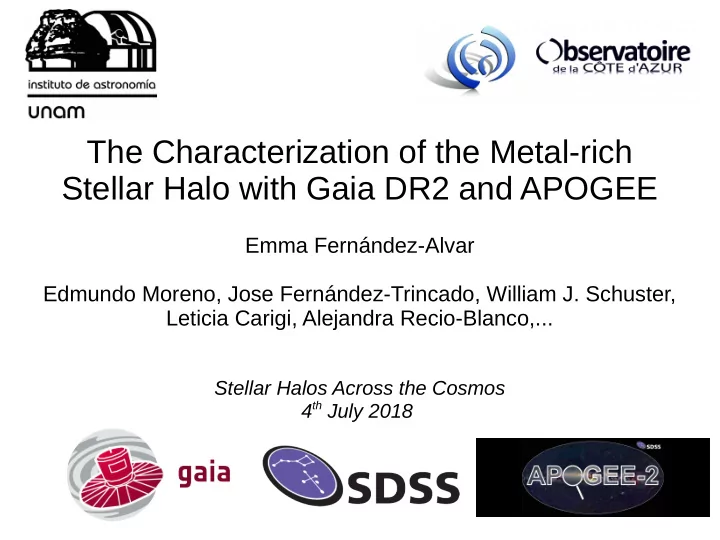

The Characterization of the Metal-rich Stellar Halo with Gaia DR2 and APOGEE Emma Fernández-Alvar Edmundo Moreno, Jose Fernández-Trincado, William J. Schuster, Leticia Carigi, Alejandra Recio-Blanco,... Stellar Halos Across the Cosmos 4 th July 2018
Stellar populations in the halo ● Halo stars: larger kinematical energy comparing to disk stars ● Within samples of halo stars: detection of different chemical trends formed by distinct formation channels: In situ Accreted (Steve Majewski’s talk)
A dual formation scenario for the Galactic halo ● Inner and outer halo differences: spatial (Deason, Belokurov & Evans 2011) , chemical (Fernández-Alvar et al. 2015,2017) and kinematical (Carollo et al. 2007, 2010; Belokurov et al. 2018; several talks here) [Ca/Fe] Fernández-Alvar et al. (2015)
The two alpha pop in the metal-rich halo (In the solar neighbourhood) Nissen and Schuster (2010)
The two alpha pop in the metal-rich halo Hayes et al. (2018a) : APOGEE database, much larger halo sample
The two alpha pop in the metal-rich halo Fernández-Alvar et al. (2018) V rad > 180 km s -1
The two alpha pop in the metal-rich halo (In the solar neighbourhood) Bonaca et al. (2017): in situ origin Helmi et al. (2018): accreted origin Haywood et al. (2018)
Our halo sample in APOGEE ● |z|>5 kpc ● 4000 < Teff < 6500 K ● 1.5 < log g < 3.5 ● Chemical abundances by ASPCAP ● Orbital parameters: GravPot16 (Fernández-Trincado et al. 2017) – V rad APOGEE (σ ~ 0.1 km/s) – Gaia DR2 proper motions – StarHorse Distances (Santiago et al. (in prep.) bayesian method from spectroscopic stellar parameters and Gaia parallaxes priors).
Metallicity Distribution Function Fernández-Alvar et al. (in prep.)
Orbital Parameters Fernández-Alvar et al. (in prep.) > z L > < E < x a m Z
Orbital Parameters Fernández-Alvar et al. (in prep.) > z L > < E < x a m Z
Orbital Parameters Fernández-Alvar et al. (in prep.) > z L > < E < See Hayes et al. (2018b) x a m Z
Fernández-Alvar et al (in prep.)
Fernández-Alvar et al. (in prep.)
Fernández-Alvar et al. (in prep.)
Conclusions ● Metal-rich halo detected at |z| > 5 kpc Splits in three [Mg/Fe] vs. [Fe/H] sequences ● Intermediate Mg/Fe stars: - KNEE of the high-alpha population - Triangulum/Andromeda candidates ● Low-[Mg/Fe] stars follow the chemical trend of the bulk of metal-poor halo stars, V distributed in 0 rotation, orbits less bound and reach larger z max , r max and r min : accreted origin ● High-[Mg/Fe] stars V distribution with primarily prograde rotation (although some in retrograde orbits). More bound and closer to the Galactic plane: disk heated origin, by a massive merger able to heat stars at such high z
Recommend
More recommend